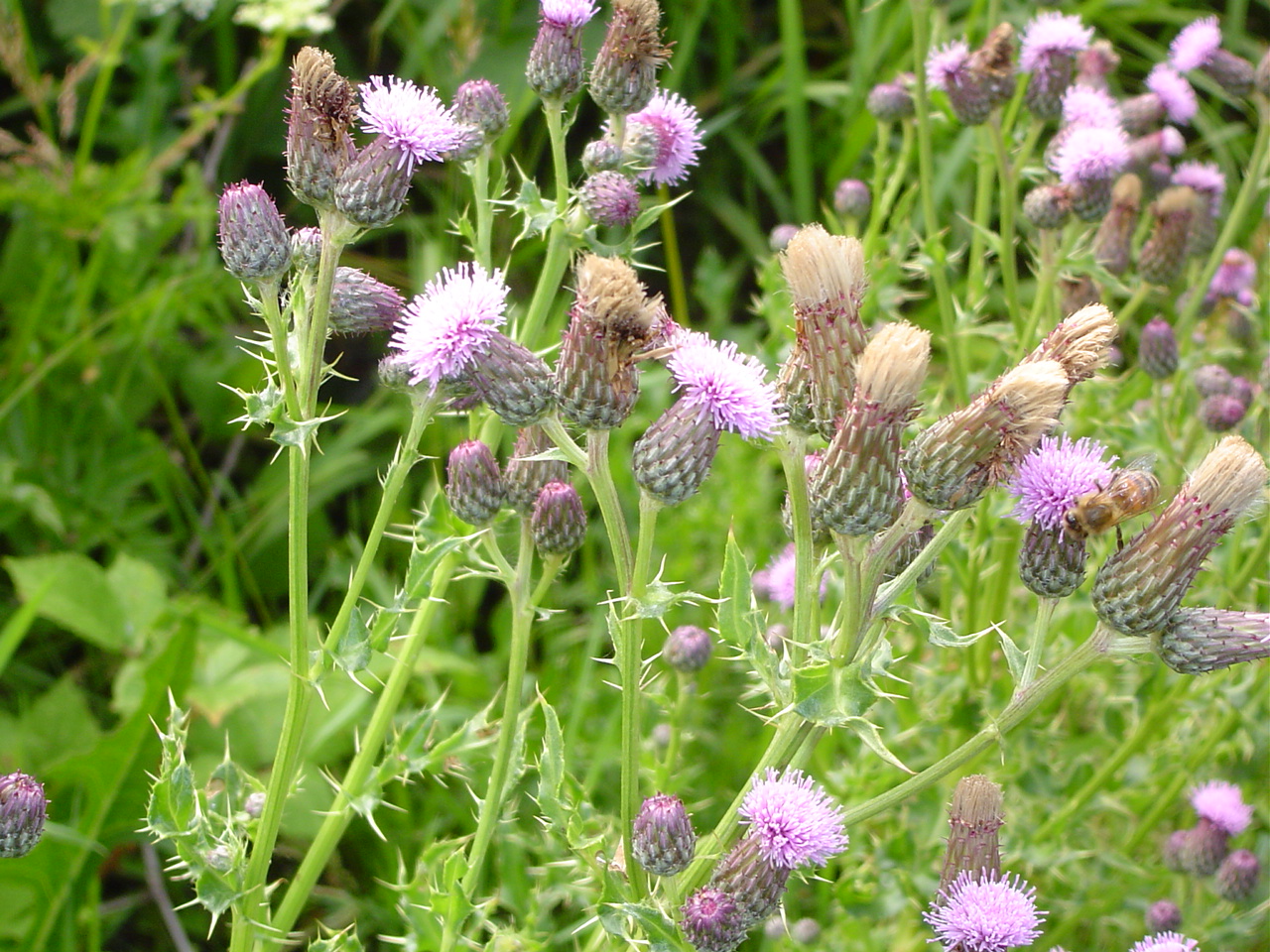Creeping thistle identification and control
About this weed
Creeping thistle is a non-regulated Class C noxious weed. This means due to how widespread it is, property owners are not required to control this species on their property, though it is encouraged.
Creeping thistle is known as Cirsium arvense and it is in the aster family. Other common names include Canada thistle.

Why it's a problem
Creeping thistle is common in pastures and croplands. It invades areas such as prairies and dunes that have natural disturbances. It also invades wet areas such as stream banks, sedge meadows and wet prairies.
Once established, creeping thistle quickly spreads, replacing native plants. It grows in circular patches, spreading through roots which can grow 10 -12' in one season. Creeping thistle threatens agriculture by reducing crop yields.
Plant description
Creeping thistle is a perennial (2+ year life cycle), herbaceous plant (not woody), native to Europe and Asia. It grows 2 to 5 feet tall and branches only at the top. Each parent plant can create clones by growing horizontal root systems (rhizomes) from where new plants can grow. This is why you often find creeping thistle in patches.
Flowers are in clusters at the tips of branched stems. Flowerheads are 1/2 to 3/4 inch wide and bloom from June to October. Flower petals are purple to pink (sometimes white). The bracts (small scale-like leaves under the flower) have a small spiny tip.
The leaves alternate along the stem and are long, narrow, and pointed. Leaf edges vary from smooth to spiny to somewhat toothed or lobed. The underside of the leaf often has hairs.
Stems begin as a circular arrangement of leaves growing close to the ground called a rosette, and then grow upright after 2 to 4 weeks. Stems can be somewhat hairy or without hairs and do not have leaf parts growing from the stem itself (winged).
Seeds are tiny with tufts of bristles that help them disperse. Plants produce 1,500 seeds on average and may produce up to 5,300 seeds.
Creeping thistle buds.

Creeping thistle flowers.

Creeping thistle rosette.

Be aware of look-alike plants
Creeping thistle is often confused with bull thistle, which is also a noxious weed. It’s important to know the two apart because they have different preferred control methods. Creeping thistle has smaller/more narrow features and is less spiny than bull thistle.
There are several native thistles that provide many habitat benefits that could be confused with creeping thistle.
The Clackamas County’s WeedWise Program is a great resource for learning to tell your native thistles apart from invasive ones like creeping thistle (noted as “Canada thistle” on their page).
The flower of spotted knapweed Centaurea stoebe could be confused with creeping thistle, but the plant has no spines. It is a Class B noxious weed and property owners in King County are required to control it. If you find this plant, please notify us.
When in doubt, take photos and report them on iNaturalist.
What to do if you find it
Because creeping thistle is so widespread, property owners in King County are not required to control it. We are not generally tracking infestations. We can provide advice on how to control creeping thistle, but there is generally no legal requirement to do so.
The King County Noxious Weed Control Board encourages property owners to remove creeping thistle where possible, and to avoid introducing it to new areas.
Control methods
We recommend using a combination of methods to control noxious weeds. In areas with few weeds, it is important to act quickly before they become harder to control. Make a long-term plan as it often takes several years to get rid of most weeds. Start in the least infested areas first and then move into more heavily infested areas.
Manual control
Creeping thistle can reproduce from root fragments. This means digging is not typically recommended (exception, small/new infestations).
For new/few plants, you can try to dig out the entire plant and all of its roots. Monitor for regrowth and pull as it surfaces.
For small/medium infestation and limited tools: cut plants down once they form flower buds, before they flower. Cut down any regrowth as it surfaces. This will eventually weaken the plants root system and prevents seeds from spreading.
Cultural control
Maintaining healthy pasture soils and competitive grasses can be effective in controlling creeping thistle. Plant crops such as alfalfa and other forage grasses.
Mechanical control
Repeated mowing once plants have flower buds may reduce populations of creeping thistle. Regular mowing can weaken stems and prevent seeding in smaller infestations. This method may take up to 4 years or more.
Biological control
Larvae of the stem gall fly Urophora cardui impacts plant vigor in creeping thistle. It causes the plant to spend energy producing gall tissue on stems instead of producing roots and flowers. This agent may hinder growth and flowering but does not kill plants or prevent spread. To learn more about the stem gall fly, please see the Introduced Thistle Biocontrol Agents fact sheet.
Chemical control
Stay safe when using herbicide:
- Always read the label before use.
- Wear a long-sleeved shirt, long pants, shoes, and eye protection.
- Follow state and local regulations.
See the PNW Pest Management Handbook for the most up to date and specific method for chemical control of creeping thistle.
Contact us or your local weed board for more information.
Disposal instructions
If plant is flowering or in seed, dispose of all plant parts in garbage. If plant is seeding, be very careful not to spread seeds.
Dispose of all non-flowering/seeding plant parts in municipal compost/yard waste. Plants may re-root in an at-home compost if it doesn’t get hot enough to completely compost the roots and stems.
Noxious Weed Disposal - Washington State Noxious Weed Control Board

 Translate
Translate